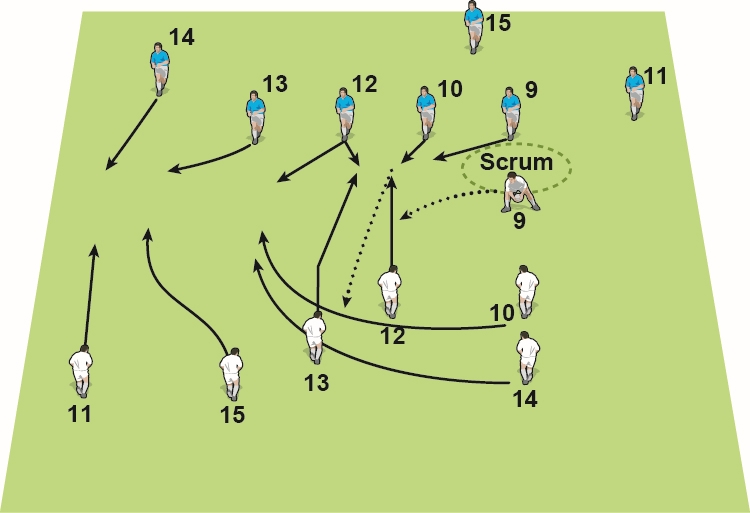The "Slider" backs move: Scrum wide strike option
Attack Tacticsby Richard Whiffin
This is an exciting play and now common in the pro-game, normally going from a scrum with multiple options. It tests the opposition with an unusual starting positioning, which forces them to make defensive reads at the line. It can be used from second phase too.
This is how England used it to score against Italy in 2015.
From an attacking scrum on the right hand side, England set up with a 10 and 14 in behind the scrum. This kept Italy’s 9 (Gori) tight to the scrum and created one-on-ones in the midfield.
England passed from 9 to 12, with 13 running a short line, checking the Italian 12 (Masi) and making him late to defend 10 (Ford) out the back.
Ford attacked the line, whilst England’s 15, (Watson) bounced out, bringing Italy’s 13 (Morisi) with him.
This, along with Ford’s dummy, created the space for 14 (Joseph) to hit the line at pace and race through untouched to score.

Set up with 10 and 14 directly behind the scrum. 12 can stand wide, outside the opposition 10. 15 can start narrow to allow for the bounce out.

9 to 12, 12 needs to attack the line and get the opposition 10 and 12 to check and step in. 10 runs a deep, wide arc, so not to get hit “man-and-ball” from 12’s pass behind 13.

10 squares up the attack, stopping the opposition 12 from drifting. 15 runs out and away from the pass, giving vocal and visual cues to sell the decoy line. 10’s dummy pass will force 13 wide leaving space for 14 to hit a line from his hidden position.
A sympathetic “shoulder” ball pass whilst blocking the defence will leave 14 in space.
With multiple options at the line, if run again, 12 and 13 could be the options if the defence drift off too early, expecting a wide play.
This is how England used it to score against Italy in 2015.
From an attacking scrum on the right hand side, England set up with a 10 and 14 in behind the scrum. This kept Italy’s 9 (Gori) tight to the scrum and created one-on-ones in the midfield.
England passed from 9 to 12, with 13 running a short line, checking the Italian 12 (Masi) and making him late to defend 10 (Ford) out the back.
Ford attacked the line, whilst England’s 15, (Watson) bounced out, bringing Italy’s 13 (Morisi) with him.
This, along with Ford’s dummy, created the space for 14 (Joseph) to hit the line at pace and race through untouched to score.
COACH THE PLAY

Set up with 10 and 14 directly behind the scrum. 12 can stand wide, outside the opposition 10. 15 can start narrow to allow for the bounce out.

9 to 12, 12 needs to attack the line and get the opposition 10 and 12 to check and step in. 10 runs a deep, wide arc, so not to get hit “man-and-ball” from 12’s pass behind 13.

10 squares up the attack, stopping the opposition 12 from drifting. 15 runs out and away from the pass, giving vocal and visual cues to sell the decoy line. 10’s dummy pass will force 13 wide leaving space for 14 to hit a line from his hidden position.
A sympathetic “shoulder” ball pass whilst blocking the defence will leave 14 in space.
HOW TO PROGRESS
With multiple options at the line, if run again, 12 and 13 could be the options if the defence drift off too early, expecting a wide play.
Newsletter Sign Up
Coaches Testimonials

Gerald Kearney, Downtown Las Vegas Soccer Club

Paul Butler, Florida, USA

Rick Shields, Springboro, USA

Tony Green, Pierrefonds Titans, Quebec, Canada
Subscribe Today
Be a more effective, more successful rugby coach
In a recent survey 89% of subscribers said Rugby Coach Weekly makes them more confident, 91% said Rugby Coach Weekly makes them a more effective coach and 93% said Rugby Coach Weekly makes them more inspired.
Get Weekly Inspiration
All the latest techniques and approaches
Rugby Coach Weekly offers proven and easy to use rugby drills, coaching sessions, practice plans, small-sided games, warm-ups, training tips and advice.
We've been at the cutting edge of rugby coaching since we launched in 2005, creating resources for the grassroots youth coach, following best practice from around the world and insights from the professional game.












